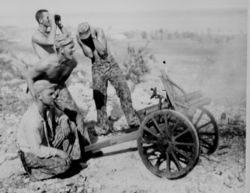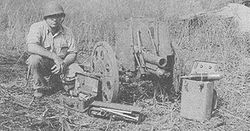
Type 92 Battalion Gun
Encyclopedia


Howitzer
A howitzer is a type of artillery piece characterized by a relatively short barrel and the use of comparatively small propellant charges to propel projectiles at relatively high trajectories, with a steep angle of descent...
used by the Imperial Japanese Army
Imperial Japanese Army
-Foundation:During the Meiji Restoration, the military forces loyal to the Emperor were samurai drawn primarily from the loyalist feudal domains of Satsuma and Chōshū...
during the Second Sino-Japanese War
Second Sino-Japanese War
The Second Sino-Japanese War was a military conflict fought primarily between the Republic of China and the Empire of Japan. From 1937 to 1941, China fought Japan with some economic help from Germany , the Soviet Union and the United States...
and World War II
World War II
World War II, or the Second World War , was a global conflict lasting from 1939 to 1945, involving most of the world's nations—including all of the great powers—eventually forming two opposing military alliances: the Allies and the Axis...
. Each infantry battalion included two Type 92 guns; therefore, the Type 92 was referred to as .
History and development
The Type 92 Battalion Gun was designed in response to issues with the Type 11 37 mm Infantry GunType 11 37 mm Infantry Gun
The was an infantry support gun used by the Imperial Japanese Army in the Second Sino-Japanese War and World War II.-History and development:The Type 11 infantry gun entered service in 1922...
and the Type 11 70 mm Infantry Mortar
Type 11 70 mm Infantry Mortar
The Type 11, was an infantry mortar used by the Japanese. It was first used in 1922 and was the first mortar to be introduced by the Imperial Japanese Army. The mortar was later replaced by the Type 92 Battalion Gun....
. Both lacked sufficient firepower and range, and infantry divisions did not like the fact that they had to carry two different types of weapons with different ammunition into combat. As a result, the Army Technical Bureau developed a design which could be used either at low angle direct fire to take out fortified positions, machine gun
Machine gun
A machine gun is a fully automatic mounted or portable firearm, usually designed to fire rounds in quick succession from an ammunition belt or large-capacity magazine, typically at a rate of several hundred rounds per minute....
nests and light armor, but also could be used at high angle indirect support fire. The caliber of the new weapon was increased to 70 mm to address the issue of inadequate firepower. The new design was available to front line divisions by 1932.
Design
Somewhat unusual in appearance, the Type 92 Battalion Gun had a short gun barrelGun barrel
A gun barrel is the tube, usually metal, through which a controlled explosion or rapid expansion of gases are released in order to propel a projectile out of the end at a high velocity....
with a split trail carriage. The barrel could be configured from a horizontal to near vertical position with a hand-crank. It had an interrupted thread type, drop breechblock mechanism. Lightweight and maneuverable, it was designed to be pulled by a single horse, although in practice teams of three horses were usually assigned. The wheel were originally wooden, but were changed to steel after troops complained that the noise from the squeaky wooden wheels was a threat.
The Type 92 Battalion Gun could fire high-explosive shells (3.795 kg (8.37 lb)), armor-piercing
Armor-piercing shot and shell
An armor-piercing shell is a type of ammunition designed to penetrate armor. From the 1860s to 1950s, a major application of armor-piercing projectiles was to defeat the thick armor carried on many warships. From the 1920s onwards, armor-piercing weapons were required for anti-tank missions...
, and smoke rounds. The propellant was semi-fixed, and could be loaded in four increments to adjust range.
Combat record
The Type 92 Battalion Gun was first used in combat during the Manchurian Incident, and was subsequently in heavy use throughout the invasion of Manchuria, the Battle of Nomonhan and subsequent Second Sino-Japanese WarSecond Sino-Japanese War
The Second Sino-Japanese War was a military conflict fought primarily between the Republic of China and the Empire of Japan. From 1937 to 1941, China fought Japan with some economic help from Germany , the Soviet Union and the United States...
. It later accompanied units assigned to the Pacific front
Pacific War
The Pacific War, also sometimes called the Asia-Pacific War refers broadly to the parts of World War II that took place in the Pacific Ocean, its islands, and in East Asia, then called the Far East...
and was used with considerable effectiveness against Allied forces
Allies of World War II
The Allies of World War II were the countries that opposed the Axis powers during the Second World War . Former Axis states contributing to the Allied victory are not considered Allied states...
throughout the South Pacific Mandate
South Pacific Mandate
The was the Japanese League of Nations mandate consisting of several groups of islands in the Pacific Ocean which came under the administration of Japan after the defeat of the German Empire in World War I.-Early history:Under the terms of the Anglo-Japanese Alliance, after the start of World...
and in Southeast Asia
Southeast Asia
Southeast Asia, South-East Asia, South East Asia or Southeastern Asia is a subregion of Asia, consisting of the countries that are geographically south of China, east of India, west of New Guinea and north of Australia. The region lies on the intersection of geological plates, with heavy seismic...
.
Surviving examples
Two guns are preserved on display in a small park on Main Street of Lakeport, CaliforniaLakeport, California
Lakeport is an incorporated city and county seat of Lake County, California. Lakeport is located on the west shore of Clear Lake, at an elevation of 1355 feet...
. The southern gun serial number 399, has unperforated sheet metal wheels, while the wheels of the northern gun appear to have been restored with new material.

